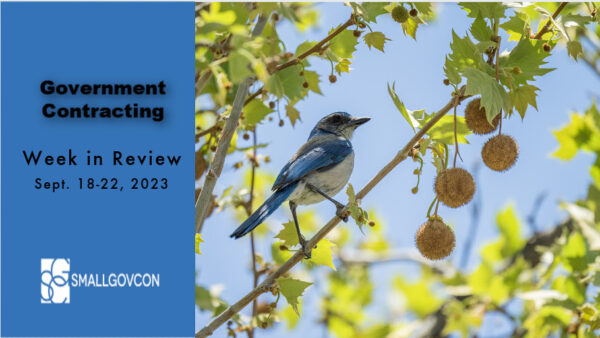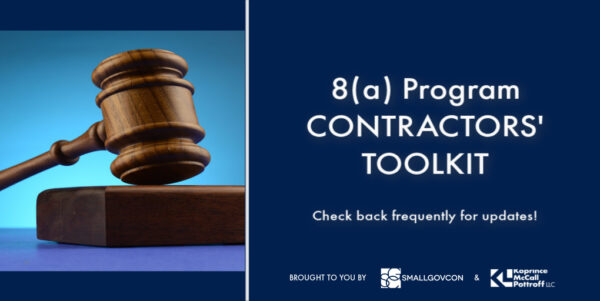We at SmallGovCon are excited to announce this first in a new line of blogs we call Why File. Our firm handles a wide variety of federal procurement and contract litigation matters–from SBA size and status protests to contract claims and appeals, and everything in between. One of the most common and important questions we get in that regard is, should I file? Of course, we can only directly answer that question for our current clients after reviewing the relevant facts giving rise to the potential filing. But through our new Why File series, we will cover some of the most common facts and circumstances that lead contractors to initiate litigation. So, without further adieu, here is the first blog in the series, covering some of the most common reasons contractors file size protests.
Continue readingAuthor Archives: Nicole Pottroff
SBA’s 2023 Update: Demonstrating 8(a) Social Disadvantage
SBA recently issued new guidance on how to demonstrate social disadvantage–one of the elements an individual must meet to be eligible for SBA’s illustrious 8(a) Business Development Program. The guidance implements a streamlined social disadvantage narrative format–limiting the number of social disadvantage instances to two and asking only for direct answers to six questions for each instance. The “new” format really just hones in on the elements SBA has always asked for 8(a) social disadvantage narratives to demonstrate, substantively, not changing a thing. Nevertheless, SBA has been quite firm in requiring this new, short and sweet, structured format–so let’s dig into it a bit.
Continue readingSBA and Industry Leaders Reaffirm Support for 8(a) Program in Light of Recent Judicial Attacks
This week, the SBA published a press release affirming its continued support of its 8(a) Business Development Program in response to recent 8(a) Program attacks in the courts. In the press release, business industry leaders across the nation joined SBA Administrator, Isabella Casillas Guzman, in praising the 8(a) Program, its successful history, and its driving policy and spirit.
Continue readingSmall GovCon Week in Review: September 18-22, 2023

Happy Friday, Readers. We hope you have had a great week and are looking forward to the weekend. Talk around the proverbial water cooler, this week, has been about the possible government shut down. On midnight, September 30th, fiscal year 23 will come to an end. Apparently, if certain things aren’t passed by Congress and signed by the President, the new fiscal year will start with a shutdown, and that has a lot of government contractors nervous.
We have included some articles on this topic and other federal government news below. Have a great weekend.
Continue readingUPDATE: SBA Opens Certify Portal for Social Disadvantage Narrative Uploads by Current 8(a) Participants Not Pending 8(a) Award
As we have previously written about in several recent 8(a) articles and updates, which can all be found on our 8(a) landing page here, SBA had previously told all 8(a) participants not pending an 8(a) award to “sit tight” and wait for the go-ahead to submit their social disadvantage narratives. Well, according to SBA’s just-released Certify Help Desk Guidance, it appears that go-ahead was just given to all the (justifiably) anxious 8(a) participants out there hoping to confirm their continued 8(a) Program eligibility as soon as possible.
Continue readingSmallGovCon & Koprince McCall Pottroff LLC Announce the 8(a) Contractors’ Toolkit

To keep federal contractors apprised of recent decisions affecting the 8(a) Program, we are launching the 8(a) Contractors’ Toolkit. The goal is to provide relevant and useful information for government contractors about eligibility, contract requirements, and best practices. We are here to help federal contractors navigate the rapidly changing waters of the 8(a) Program.
Check back regularly as we cover various topics bearing on federal contractors currently participating in or hoping to gain entry into the 8(a) Program. We will regularly and promptly update the site to keep our readers informed of all updates, clarifications, and guidance regarding the 8(a) Program, as they are released.
We understand that things may feel a bit uncertain and overly complex in the 8(a) Program at this time. Our greatest hope is that this collection of specific information on the current changes to the 8(a) Program and social disadvantage narratives will guide contractors in drafting their narratives, but we are also here to help anyone who needs assistance. More information is available at this link.
If you are needing legal assistance, please reach out at info@koprince.com or call 785-200-8919.
8(a) Social Disadvantage Narratives: What SBA is Looking For–Now, From ALL Individually-Owned 8(a) Applicants and Participants
Writing a social disadvantage narrative for application to SBA’s 8(a) Business Development Program has always been an arduous undertaking–to say the least. And up until a recent Federal District Court decision (which we blogged on here), only a small portion of 8(a) Program applicants had to submit this time-consuming, highly personal, difficult task. But now (as discussed in the above-linked blog and in this blog on SBA’s recent actions in response to the decision), this requirement is being expanded to all individual applicants that haven’t already provided a social disadvantage narrative. You can read much more about SBA’s implementation of this here. But essentially, you will need to write a social disadvantage narrative if you are an individually-owned1 8(a) applicant or program participant who is trying to get into the 8(a) Program or already in the 8(a) Program–even if you were planning to or already had relied on the rebuttable presumption of social disadvantage (which SBA can no longer use).
Fortunately, we have been drafting these narratives for a long time now, meticulously studying and utilizing: (i) SBA’s rules, policies, and guidance on social disadvantage narratives (recent guidance can be found here); (ii) SBA’s feedback on individual narratives; and (iii) SBA’s Office of Hearings and Appeals (OHA) decisions covering the SBA’s initial appealed decisions on applicants’ social disadvantage eligibility–as well as OHA’s final decisions on the appeals. So, while SBA’s current regulations and guidance can guide your pen, they are certainly not the only source of helpful information out there. Let’s take a look at some SBA guidance and recommendations based on SBA’s actual decisions that may increase your chances for success.
Continue reading